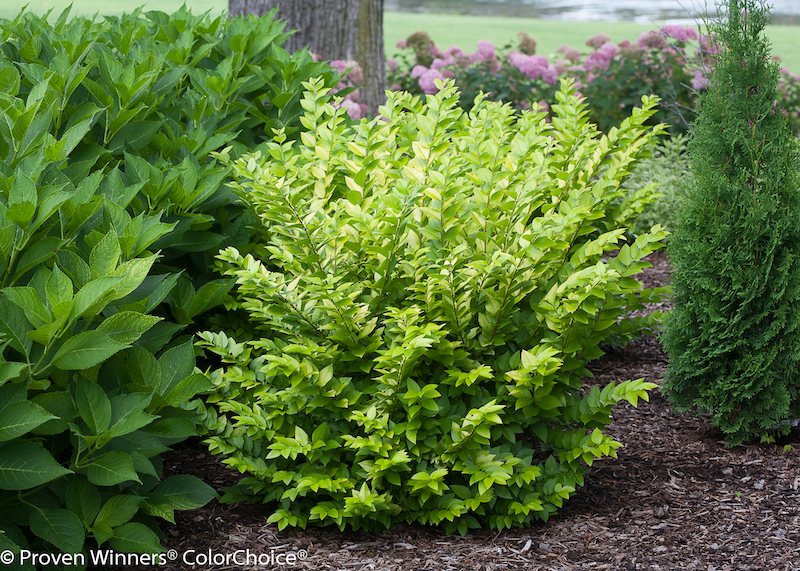The hardy and evergreen privet is undeniably useful for informal or formal hedging or the structural backbone of a foundation plantings. This low-maintenance shrub not only features attractive glossy foliage but also has sweetly scented flowers that attract native pollinators in droves. Pair privet with many different shrubs, perennials, and annuals to accommodate any garden theme or style. Privet can be closely clipped into topiary or a formal low-growing hedge when planning a sophisticated white garden. Or allow privet to take on a natural shape, so it can flower freely and set black berries in a naturalized or wildlife-friendly garden plan.

No matter how you incorporate privet in the garden, make sure the planting site drains well year-round. For the best blooming, site this adaptable shrub in at least 6 hours of direct sun.
Shrubs To Plant With Privet
Privet can grow alongside a long list of other shrubs either in formal or informal settings. Arborvitae, boxwood, euonymus, holly, juniper, pittosporum, and false cypress all grow happily next to privet and provide contrasting foliage color and texture. For a wildlife planting, consider using flowering shrubs such as rose of Sharon, potentilla, hydrangea, oleander, abelia, shrub roses, and flowering quince, which set valuable seeds or fruit for wildlife and work well as a successional planting. Choose early, long-blooming varieties to provide nectar and pollen for pollinators and flowers for the gardener.

Perennials To Plant With Privet
Privet makes an outstanding solid backdrop for brightly colored blooming perennials. Plant a row behind agapanthus, peony, lady’s mantle, New Zealand iris, and Japanese anemone, which feature beautiful foliage and showy, enduring flowers. Peonies in particular have fabulous fall foliage that would make a dramatic statement when planted in front of a privet living wall. Privet also pairs well with popular foliage plants, such as hostas and ferns planted in part sun to part shade. For sunny areas, grow low-growing ornamental grasses, sedum, and echeveria as ground cover plants near privet for a low-maintenance design.
Annuals To Plant With Privet
Annuals are often the final element for any garden design. They can be used to fill in large spots left between shrubs and perennials before they reach maturity. Planting annuals with privet can be a great way to add seasonal color to a permanent foundation planting or informal hedge. Early in the spring, pansies, violas, and petunias will reliably bloom during somewhat unpredictable temperatures. From early summer to fall, impatiens, wax begonias, dianthus, and flowering vinca can take over the ground cover duties until the first frost in fall. Using annuals as a seasonal ground cover allows the gardener to change color schemes or try out different plant species from year to year for little cost compared to planting perennials.
Best Companion Plants For Privet in Containers
Dwarf types of privet are best suited to container growing. Try planting a golden variety of privet as the thriller element. The vibrant golden shade looks amazing when highlighted by the dark maroon foliage of a sweet potato vine and bright orange shades of ornamental carex grass or New Zealand iris (libertia). With the year-round color of the privet and carex grass, this planter design will look fresh even during the winter when the sweet potato vine has died back. Fertilize mixed containers of shrubs and perennials once late in the spring with a slow-release balanced fertilizer, which will supply nutrients at each watering.

Plants Not To Grow With Privet
Aggressively growing plants are not ideal companions for privet. Wisteria, in the right conditions, is a rapid-growing vine that can overwhelm even the tallest of deciduous trees. Wisteria becomes incredibly heavy in as little as one season and can pull down branches and stems of even a mature privet hedge.
Suckering shrubs are also not recommended to plant near privet. Lilacs, false spirea, sumac, and snowberries all spread by sucker roots that grow into separate shrubs if not pruned out regularly. The suckering roots can pop up virtually anywhere, even in the interior of other shrubs, and make control very difficult.
Best Plants To Grow With Privet
Privet looks best when grown as part of either an informal or formal hedge. Pair it with formal clipped hedges like yew, boxwood, and Japanese holly for a smart, crisp look to any garden setting. Left unpruned, the privet provides year-round structure and habitat for wildlife in a naturalistic garden setting.
 |
Author Robbin Small - Published 10-05-2023 |
